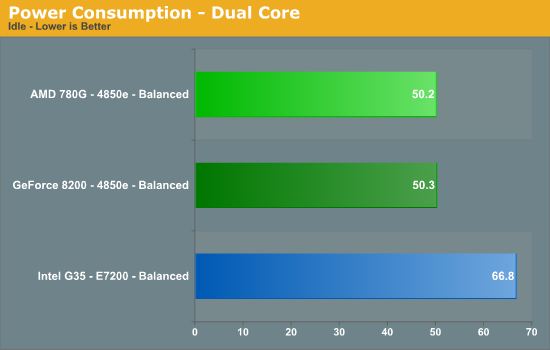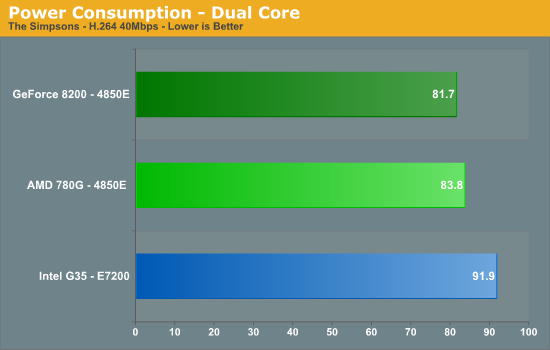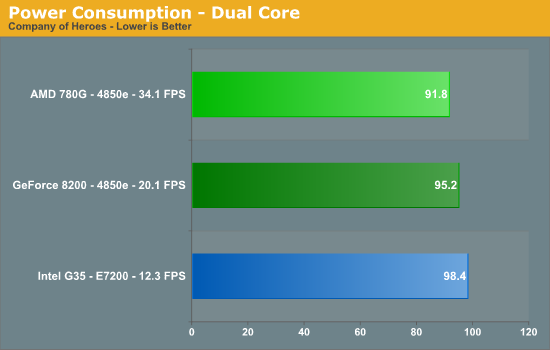We took a first look at power consumption numbers from the latest integrated graphics platforms and came away with some surprising results at the time. As we mentioned in the original article, our initial focus was on the platform and not chipsets. Little did we know the reaction this focus would create from both the manufacturers and readership. As expected, the chipset/processor manufacturers had their own opinions about our results and offered a wealth of information about their internal results and test practices.
We learned a great deal, about how Intel, NVIDIA, and AMD arrive at their reported numbers, but more importantly that each company arrives at their final results just a little differently. We will get into that subject matter and more in our first specific power consumption article. As for today, we are going to provide some quick results based on our current testbeds utilizing the AMD 780G, NVIDIA GF8200, and Intel G35 chipsets.
After completing power consumption numbers on twelve boards (results on Monday) featuring these latest chipsets, it became obvious that each manufacturer implements power management capabilities of the chipsets and processors in a variety of ways. Even testing the same chipset from two different board suppliers with like BIOS options resulted in measurable differences. Based on previous testing this was not a real surprise to us. However, after specifically focusing on power management capabilities the differences in options between each BIOS and even how standard features are implemented shocked us to some degree. At least to a degree that we will spend significantly more time and effort on reporting power management options and results in future articles.


In our first article, we utilized boards from different manufacturers, enabled each power option available in the BIOS and standardized Vista's power management schemes. Although each BIOS option appeared similar, the results turned out to be quite different between manufacturers. In fact, it was the power management features missing that provided the biggest differences between boards.
After weeks of discussion with AMD, Intel, and NVIDIA about the variety of power management options available in the core BIOS code and then comparing that information to what the supplier implements, we turned our attention to the board suppliers to provide significantly better power management features. Not only have most responded with improved features or performance, it also appears a greater emphasis from the chipset manufacturers is occurring at this time on new product releases.
As such, our testing today will utilize boards from Biostar for the AMD 780G and GeForce 8200 chipsets. The reason being is that most board suppliers will utilize like BIOS code and features along with components for their entry level boards in order to save costs. Biostar does not supply a G35 board so we will stick with our ASUS sample. ASUS also offers 780G/GF8200 boards that are very similar to each other in design and price. However, the current boards are being phased out. They will be replaced shortly by new boards with improved feature sets and the capability to handle 140W TDP processors.
The important point to make here is that 780G/GF8200 boards from Jetway and ASRock each had very similar BIOS options and board layouts that resulted in comparative numbers between these two chipsets. Our two Biostar boards do differ, as the 780G is a uATX format while the GF8200 is a standard ATX format board. However, the Biostar GF8200 board offered the best power consumption numbers in our roundup testing so we will use it as a best-case example. The same applies for the 780G board from Biostar.
Since our initial article, each board has received several BIOS upgrades along with significant driver changes from the chipset manufacturers. In doing A/B comparisons between each BIOS and driver change, we did notice improvements in power management for the Intel and AMD products while the NVIDIA numbers increased slightly due to additional performance and features provided by the latest driver set. We also changed our power supply, fan count, hard drive, and memory components to represent our standard test bed options for future articles.



At idle, the 780G and GF8200 basically tie now. In previous testing with the Gigabyte 780G board, the 780G was about 7W higher at idle than the Biostar GF8200. The Intel G35 dropped about 8W after the 0506 BIOS update along with a change in the retail cooler for the E7200. The H.264 playback numbers favor the AMD and NVIDIA chipsets as they feature hardware acceleration for H.264 that Intel is lacking until the G45 arrives. However, the Intel number did improve around 12W after the latest BIOS, driver, and PowerDVD Ultra updates. In our final test, the GF8200 performs the best from a pure wattage vantage viewpoint. The 780G actually has the best performance per watt rating based on a 70% increase in frame rates with only a 5% increase in power compared to the GF8200. The G35 is not recommended for most recent game titles so we will not even comment further on its results.
We will be back on Monday with a look at several different boards and further information about power management features along with performance per watt in additional titles. In the meantime, we were impressed with the attention Biostar has placed on power management in their IGP boards along with the improvements of our G35 board after a series of BIOS and driver upgrades.










30 Comments
View All Comments
James5mith - Wednesday, July 2, 2008 - link
I'd just like to say that I appreciate everything Gary Key and his team does. But there has been more than a few posts in the past promising a full article within the next week, after the weekend, on Monday, etc.What's the actual ETA on the IGP roundup? Is it being indefinitely postponed until the G45 is released?
deruberhanyok - Monday, June 23, 2008 - link
"In our final test, the GF8200 performs the best from a pure wattage vantage viewpoint. The 780G actually has the best performance per watt rating based on a 70% increase in frame rates with only a 5% increase in power compared to the GF8200."-----
The 780G shows LOWER power use than the 8200 in your final chart... the 8200 is the one using slightly more (~3%) power.
Did I miss something?
omdurman71 - Tuesday, June 24, 2008 - link
No. Clearly there is an error either in the labeling in the chart or the accompanying text.grohele - Saturday, June 21, 2008 - link
I don't care which is better, Intel or AMD. I just want my kitten back!idave101 - Thursday, June 19, 2008 - link
I realize the article is for comparison purposes... the PSU used is fine for comparing the 3 systems. But FYI for the readers, using a PSU at a good efficiency (80+%) that is more in-line with the expected power consumption would achieve even lower power usage.This is because the efficency of a PSU is a sloping curve from 0W up to a point that is usually 1/3 of the total power avaialable. So it only achieves its max efficency at 200 or so Watts in this case. So at 70 watts, the PSU's efficency is actually less than maximum. Using a 300W 80+ PSU would give you max efficency at about 100W.
My Quad Core Q6700 rig for instance, similar set-up to the Intel machine here idles at 73W, max load = 110w. I use a seasonic 330W 80+ PSU. Its dead quiet too FYI.
CSMR - Thursday, June 19, 2008 - link
G35 is old and even when it was current was disappointing. G35 results are not interesting. It's power consumption and performance are sub-par; we knew that already. G45 on the other hand is a very promising chipset. People are waiting to buy G45 and so a comparison with other new chipsets would be much more interesting.Calin - Monday, June 23, 2008 - link
Yes, but we might talk about the G45 and the Fusion technology from AMD, of G45 and the GeForce 9100, or AMD 870G.I would love an article about G45 and its graphic capabilities - as soon as it is available to Anandtech. Until then, let's leave the future platforms for the future, and look at the current, existing platforms.
yehuda - Friday, June 20, 2008 - link
It's a pity G45 is being delayed. I can't wait for it to arrive. In particular, I'm looking forward to Gigabyte's GA-G45M-DS2H board.derek85 - Thursday, June 19, 2008 - link
Sure the G35 is old, and it might be unfair to compare that to the more recently introduced 780s from AMD and NVidia (funny they are both 780...). But Intel really have to fix their drivers before they can sell any of their integrated parts to me, regardless of how good their hardware can be. Currently they are miles behind AMD and NVidia's in this regard.CSMR - Thursday, June 19, 2008 - link
oops I meant "its"